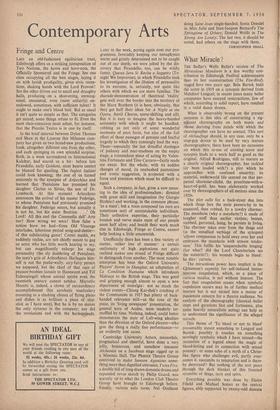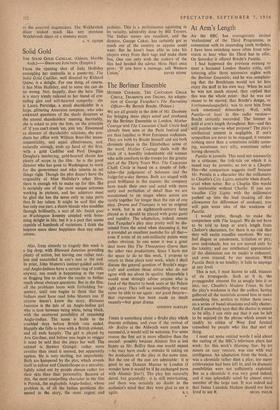What Miracle'?
THE Sadler's Wells Ballet's version of The Miraculous Mandarin is a less worthy con- tribution to Edinburgh Festival achievements than its last reconstruction (The Fire-Bird), staged here two years ago. Bela Bartok built the score in 1919 on a synopsis derived from Melchior Lengyel; in recent years many ballet companies have essayed resurrections, few of which, according to solid report, have resulted in a valid dance drama.
What is observably wrong on the present occasion is this idea of constructing a sig- nificant choreography on both music and theme deriving from minds with which the choreographer can have no contact. This sort of rechauflage should, in any case, only be a stop-gap device to be used by very mature choreographers; there have been no occasions on which this re-use of existing score and synopsis leads to a work half as good as the original. Alfred Rodrigues, still to mature as a clearly original choreographer, has tackled (or been loaded with?) a plot which he approaches with confused sincerity; its material, underworld life centred on that per- petual character-clich6, the prostitute-with-a- heart-of-gold, has been elaborately worked over by choreographers of all nations since the I 9 2 Ohse. T
plot calls for a back-street den into which thugs lure the male passers-by to be ensnared, then robbed, by a tawdry charmer. The mandarin (why a mandarin?) is made of tougher stuff than earlier victims; beaten, stabbed, garrotted, hung, he persists in living. The charmer takes over from the thugs and (in the unsullied verbiage of the synopsis) 'allows compassion to hold sway over her and embraces the mandarin with utmost tender- ness.' This fulfils his 'unquenchable longing' (for what? did the Lord Chamberlain see the scenario?): his wounds begin to bleed: he dies: curtain.
The miraculous power here implicit is the Chinaman's capacity for self-induced instan- taneous coagulation, which, as a piece of curiosa medica, is not without interest. The fact that coagulation ceases when, symbolic copulation occurs may be of further medical interest but is not turned into a matter of passionate concern for a theatre audience. No analysis of the choreography (classical ballet steps and gyrations fast and fortissimo, plus some heavily naturalistic acting) can help us to understand the significance of the alleged miracle.
This theme of 'To bleed or not to bleed' presumably meant something to Lengyel and Bartok; possibly it touches on something movingly symbolic which 1 have missed—the recreation of a legend about the magic of blood-letting and its connection with sexual potency: or some echo of a myth of a Christ- like figure who challenges evil, partly over- comes it, succumbs to temptation and is there- by destroyed'? But nothing of the sort peers through the dark blanket of this frenzied scramble of thugs, tarts and spivs.
Everything possible was done by Elaine Fifield and Michael Somes as the central figures, ably supported by twenty-odd dancers



































 Previous page
Previous page